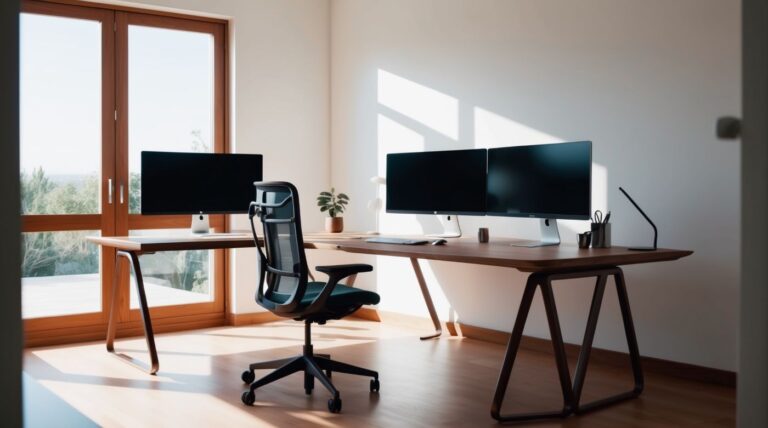How to Build a Daily Work from Home Productivity Routine
Working from home can sound like a dream—no commute, flexible hours, and the comfort of your own space. But let’s be real: work-from-home productivity routine isn’t as easy as it seems. Distractions are everywhere, from the laundry that “needs” to be done to the lure of just one more episode on Netflix. Without a clear work-from-home productivity routine, it’s easy for the lines between work and personal life to blur, leading to stress and lowered output.
That’s why building a routine that keeps you focused and motivated is crucial. In this article, I’ll share practical tips and habits that can help you create a daily schedule that works for you.
Whether you’re trying to balance family time, home responsibilities, or just need to find your flow, these strategies will help you organize your day, stay on track, and achieve that perfect balance between work and life.
The Importance of a Structured Routine
When it comes to remote work success, having a structured routine isn’t just nice to have—it’s essential. Without a plan, the day can spiral into chaos, with missed deadlines, low motivation, and the ever-present feeling of not getting enough done. A solid routine helps bring structure and discipline to your day, making sure you stay on top of tasks and hit your goals.
Let’s compare: On a day without structure, you might wake up whenever, start work late, and find yourself distracted by personal tasks, only to realize by 5 PM that you’ve hardly made progress.
On the other hand, a well-planned day starts with intention—clear working hours, breaks scheduled for rest, and specific times for high-focus tasks. This difference is what turns an unproductive day into an efficient one.
By sticking to a consistent productivity schedule and managing your time effectively, you’ll notice a major boost in focus and output. This isn’t about working longer hours—it’s about working smarter. When your routine is dialed in, you can achieve more in less time and still maintain the clarity needed to manage both work and personal life.
How to Create an Effective Work from Home Productivity Routine

Working from home sounds great until you’re halfway through the day and realize you’ve been distracted by a hundred little things that wouldn’t exist in an office setting. That’s where having a solid routine comes in. It’s not just about getting stuff done—it’s about setting yourself up for success, day after day, by creating a flow that feels natural but keeps you on track. Let’s dive into how you can build that perfect work-from-home productivity routine that works for you.
Start Your Day on the Right Foot
The morning sets the vibe for everything that follows. If you roll out of bed and dive straight into work, you’re probably not giving yourself enough time to energize and mentally prepare. A strong morning routine is your secret weapon to feeling refreshed and ready to tackle the day.
For example, start with some light exercise, mindful meditation, or even a few minutes spent planning your day. These activities may seem small, but they make a huge difference in how you kickstart your productivity. Personally, I find that knocking out a quick workout gives me the mental clarity to dive into tasks with purpose. Find your thing, but whatever it is, make sure it helps you prepare for the day ahead.
Set Clear Work Hours and Breaks
One of the biggest challenges with remote work? It’s all too easy to let work hours bleed into your personal time. Before you know it, you’re answering emails at 10 PM, and your whole work-life balance is out the window. The solution? Define clear work hours and stick to them.
Set a specific start time and, more importantly, an end time. If you don’t, you’ll feel like you’re always “on,” and that’s a fast track to burnout. Also, remember to take regular breaks—using something like the Pomodoro technique can help you regulate your focus and energy throughout the day.
A good rhythm might be 90 minutes of work followed by a 10-15 minute break. This balance lets you manage your energy without burning out halfway through the day.
Design Your Home Office for Productivity
Your workspace is more than just a desk and a chair—it’s a reflection of your mindset. A cluttered workspace equals a cluttered mind. That’s why designing a dedicated home office can make a world of difference in your remote work habits.
Let’s break down what you need to create an environment that fuels focus and gets the most out of your day.
The Role of an Organized Workspace
Ever notice how much more focused you are in a clean, organized space? That’s not a coincidence. A dedicated workspace organizes your mind just as much as it does your stuff. When everything is in its place, you’re less likely to get distracted by random things.
To really optimize your home office for productivity, think about ergonomics too. Make sure your desk setup is comfortable—because if your body isn’t in a good position, your focus will suffer. Small changes like adding a proper chair, setting up good lighting, or even organizing your desk can have a massive impact on how productive your day feels.
Must-Have Tools to Stay Productive
Let’s face it—without the right tools, staying on task can feel like an uphill battle. Whether it’s a simple to-do list or a full-blown project management app, having the right tools in your toolkit can really streamline your workflow.
Consider apps like Trello for organizing tasks or Focus@Will to block out distractions. Personally, I’m a fan of time-tracking apps that help me stay on task while also showing me where my time actually goes. These tools are designed to enhance your productivity by automating the smaller tasks, so you can focus on what really matters.
Maintaining Work-Life Balance
If there’s one thing remote workers struggle with, it’s separating work from personal life. When your home becomes your office, the lines blur quickly, and before you know it, you’re answering emails at dinner. This is where setting boundaries becomes crucial, both for your productivity and your mental health.
The Importance of Boundaries
The key to protecting your personal time is drawing a firm line between work and home life. It’s easier said than done, but one trick that works well is creating a mental “commute”—something you do before and after your workday that helps signal a shift in mindset. For example, take a quick walk before you start your day and after you finish. This small routine divides your time, helping you transition between work mode and home mode more smoothly.
Setting remote work boundaries will protect your productivity while also ensuring you’re fully present in your personal life. Trust me, once you establish those boundaries, the benefits are huge.
Healthy Habits for Long-Term Productivity
Staying productive long-term isn’t just about managing tasks—it’s about taking care of yourself too. Regular breaks, staying hydrated, and moving around throughout the day are small habits that sustain your focus and keep you sharp.
For instance, setting reminders to drink water or taking a short walk every hour or two can rejuvenate your mind and body, keeping you energized throughout the day. It’s all about building small, healthy habits that contribute to your overall long-term remote productivity.
Overcoming Remote Work Challenges

Let’s be honest—working from home sounds great in theory, but it comes with its own set of challenges. From distractions all around to the occasional feeling of isolation, remote work can sometimes be more difficult than expected. But with the right strategies, you can manage and overcome these challenges to stay productive and focused. Here’s how.
Minimizing Distractions at Home
Distractions at home are inevitable, whether it’s family members walking in, noisy neighbors, or social media pulling your attention away from work. The good news? You can take practical steps to eliminate most distractions and create a more focused work environment.
One strategy I use is setting up “do not disturb” periods. During these times, I communicate with family members that I need uninterrupted work time. Noise-canceling headphones are also a game-changer, helping block out distractions like household noise or construction outside. And when it comes to social media? Try using apps like Freedom or Cold Turkey to temporarily block access during work hours. These simple steps can help manage your environment and keep you on task.
Real-life example: I once had a day packed with deadlines, but constant notifications from social media kept pulling me away. After installing an app to block distractions for 60-minute intervals, I noticed my focus improved drastically, and I got through my tasks much faster.
Combatting Isolation
One of the more subtle challenges of remote work is the isolation that comes with it. You might be physically comfortable, but working solo day in and day out can leave you feeling disconnected from your team. But don’t worry—there are ways to connect and stay engaged with others.
The key is to be intentional about maintaining relationships. Schedule regular virtual check-ins with colleagues or friends. Even a 10-minute chat on Slack or Zoom can make a big difference in how connected you feel. Additionally, joining online communities or participating in virtual coworking sessions can help foster a sense of collaboration and shared purpose, even when you’re physically apart.
The best part? These interactions don’t need to be formal. A casual conversation about a weekend project or a quick brainstorm with a coworker can engage you socially and break the monotony of working alone.
Conclusion
The benefits of a structured daily routine for remote work go beyond just staying organized—they directly contribute to your overall productivity and work-life balance. By setting clear work hours, minimizing distractions, and building in breaks, you’re setting yourself up for long-term success.
So, what’s next? Start small. Make minor tweaks to your current routine, test them out, and see how they improve your focus and output. Over time, you’ll build a system that works perfectly for your needs.
Ready to improve your work-from-home productivity? Start building your routine today for better focus, balance, and a smoother workday.
FAQ Section
What are the best practices for staying productive while working from home?
To stay productive, create a dedicated workspace, set a consistent schedule, and take regular breaks to avoid burnout. Using productivity tools like task managers can also help keep you on track.
How can I avoid burnout while working remotely?
Set clear boundaries between work and personal time. Taking regular breaks, staying hydrated, and getting enough sleep are essential to maintaining energy and focus throughout the day.
What tools can help me stick to a daily routine at home?
Apps like Todoist, Focus@Will, and RescueTime are great for managing tasks and keeping distractions at bay. These tools help you track time, organize your tasks, and improve focus.
Disclaimer
“This article is for informational purposes only. Results may vary depending on individual work environments.”







